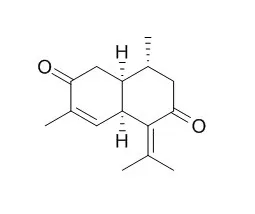| Kinase Assay: |
| Oncol Rep. 2015 Apr;33(4):1823-7. | | Induction and mechanism of HeLa cell apoptosis by 9-oxo‑10, 11-dehydroageraphorone from Eupatorium adenophorum.[Pubmed: 25647450] | 9-Oxo-10,11-dehydroageraphorone (euptox A), a cadenine sesquiterpene, is the main toxin from Eupatorium adenophorum. The aim of the present study was to examine the induction and mechanism of HeLa cell apoptosis by 9-Oxo-10,11-dehydroageraphorone.
METHODS AND RESULTS:
The apoptosis‑inducing effect of the 9-Oxo-10,11-dehydroageraphorone on HeLa cells was examined by MTT assay. The underlying mechanism was analyzed by flow cytometry and quantitative PCR. Flow cytometry results suggested that 9-Oxo-10,11-dehydroageraphorone effectively inhibited the proliferation of HeLa cells, arrested the cell cycle transition from S to G2/M phase, did not continue to complete the cell cycle activity (mainly from 4 times and mitosis), and induced cell proliferation.
CONCLUSIONS:
The RT-qPCR detection results showed that 9-Oxo-10,11-dehydroageraphorone induced apoptosis by improving the gene expression level of apoptotic proteases such as caspase-10 in HeLa cells. Its mechanism of action was associated with the upregulation of apoptotic gene expression and arresting of the cell cycle. |
|
| Animal Research: |
| BMC Vet Res. 2014 Dec 20;10:970. | | Clinical efficacy of 9-oxo-10, 11-dehydroageraphorone extracted from Eupatorium adenophorum against Psoroptes cuniculi in rabbits.[Pubmed: 25527276] | Animal acariasis is one of the important veterinary skin diseases. Chemical drugs have been widely used to treat and control this kind of disease. But many chemicals control could increase resistance in target species, toxicity and environmental hazards. We found that the 9-Oxo-10,11-dehydroageraphorone(euptox A) extracted from E. adenophorum has strong toxicity against P. cuniculi in vitro, but the in vivo acaricidal actions of euptox A have yet to be investigated.
METHODS AND RESULTS:
A 14-day experiment was performed using rabbits that were naturally infested with P. cuniculi on a farm. Rabbits were randomly divided into five groups; animals in groups A, B and C were treated in each ear topically with 4.0 ml of 2.0 and 1.0 g/L (w/v) euptox A, respectively. Animals in groups D and E were treated with ivermectin (by injection; positive controls) and glycerol with water only (by embrocation; negative controls), respectively. Each rabbit was treated twice with separate treatments on days 0 and 7. Rabbits were observed daily and detailed examinations were performed on days 0, 7 and 14, to inspect the presence or absence of mites and scabs/crusts. Seven days after the initial treatment, the mean clinical scores (presence of scabs/crusts) decreased from 3.48, 3.37, 3.43 and 3.45 to 0.37, 0.42, 0.78 and 0.38 in the ears of animals in groups A, B , C and D, respectively, which were similar to the observations recorded in the positive control rabbits. However, the clinical score for negative control rabbits did not increase significantly (P > 0.05) during the experiment, and this changed from 3.32 to 3.37 in the ears, and there were no significant differences in clinical efficacy between left and right ears. After two treatments (0 and 7 d), the rabbits in groups A, B, C and D had recovered completely 14 days after the last treatment and no recurrences of infection were observed.
CONCLUSIONS:
These results indicate that euptox A was potent compounds for the effective control of animal P. cuniculi in vivo. |
|






 Cell. 2018 Jan 11;172(1-2):249-261.e12. doi: 10.1016/j.cell.2017.12.019.IF=36.216(2019)
Cell. 2018 Jan 11;172(1-2):249-261.e12. doi: 10.1016/j.cell.2017.12.019.IF=36.216(2019) Cell Metab. 2020 Mar 3;31(3):534-548.e5. doi: 10.1016/j.cmet.2020.01.002.IF=22.415(2019)
Cell Metab. 2020 Mar 3;31(3):534-548.e5. doi: 10.1016/j.cmet.2020.01.002.IF=22.415(2019) Mol Cell. 2017 Nov 16;68(4):673-685.e6. doi: 10.1016/j.molcel.2017.10.022.IF=14.548(2019)
Mol Cell. 2017 Nov 16;68(4):673-685.e6. doi: 10.1016/j.molcel.2017.10.022.IF=14.548(2019)